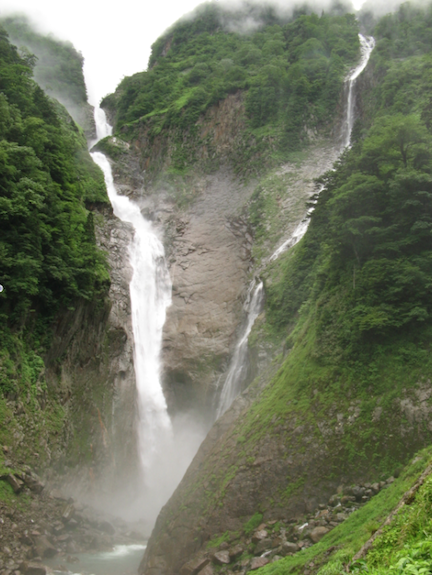Gendered Kanji
If you sought kanji with which to make gender distinctions, what would you use? My mind would naturally go to these two:
男 (54: male, man)
女 (35: female, woman)
These characters can indeed serve that purpose, but they don't always mean what you might think. Moreover, some other pairs of kanji also distinguish male from female.
Size Matters
Let's start by looking more closely at 男 and 女. These can represent size differences. According to Dr. Gabi Greve, a longtime Japan resident and creator of the Daruma Museum, male-female size designations apply to twin mountain peaks. People call the larger one 男体山 (なんたいさん) and the smaller one 女体山 (にょたいさん). Clearly, they're not identical twins! One finds an example of this on Mount Tsukuba.
However, 男体山 and 女体山 are not always paired. There are several instances of 男体山 with no 女体山 in sight.
Twin waterfalls also attain 男- and 女- designations. Essay 1550 on 滝 (waterfall) presents these terms:
男滝 (おだき: greater of two waterfalls) male + waterfall
女滝 (めだき: smaller of two waterfalls) female + waterfall
Here, gender indicates the width and volume of the waterfalls. That is, if two waterfalls are near each other, the wider and more voluminous one is called 男滝, whereas the narrower one with less water is 女滝. Whereas height is the determining factor with gender designations for mountains, that's apparently not true with waterfalls.

Photo Credit: Kahusi
In Toyama Prefecture, the 497-meter (1,640-foot) Hannoki Falls (ハンノキ滝) on the right is the highest in the country, but it contains water only from April through July as snows from the nearby plateau melt. When Hannoki Falls runs dry, neighboring Shomyo Falls (称名滝, しょうみょうだき) which is 350 meters (1,148 feet), takes over as tallest.
Japan's tallest waterfall, Hannoki Falls, is part of a pair. In the photo above, Hannoki is on the right, and Shomyo Falls is on the left. It looks like, even when Hannoki has water, it's thinner. Despite being taller, it must be the female.
It seems to me that women usually have much wider hips than men, so the waterfall nomenclature struck me as funny. However, my proofreader tells me that women are typically narrower than men in Japan.
All of this makes me rethink what it is to be male or female! If I were asked to define the male essence or the feminine mystique, my mind would never go to height, width, or certainly volume of water!
Birds of a Gender
As essay 1550 on 滝 indicates, there are two synonymous (and homophonic) ways to represent the same concept when it comes to paired waterfalls:
雄滝 (おだき: greater of two waterfalls) male + waterfall
雌滝 (めだき: smaller of two waterfalls) female + waterfall
Note that both 雄 (1869: male) and 雌 (1323: female) have birds in them! That is, 隹 (radical 172: the "old bird" radical) appears in both kanji. It does indeed mean "bird" in those characters, says Henshall in his newer edition. In his etymology for 雌, he notes that the left-side phonetic has the associated sense "small" and that the smaller bird in a pair is usually the female. His analysis of 雄 is far more complicated, so I won't explore that here.
The same two gendered kanji recur in the following pair of terms:
雄飛 (ゆうひ: to launch into (politics, etc); embark on (a career); do a great thing (in a certain field; abroad; etc.) masculine, gallant + flight
雌伏 (しふく: to lie low, awaiting one's chance; bide one's time; pocket one's pride)
feminine, obedient, enduring + to crouch
Men certainly get to have all the fun! Acknowledging how sexist these terms sound, my male proofreader explains that they originate from observations of avian behavior. According to his source, male birds fly magnificently, whereas female birds keep their heads down and obey the males. Ah, but there's some gender-bending when it comes to the metaphorical applications. That is, a female can turn into a male, figuratively speaking. As my proofreader explains, Japanese people often say that someone is finally doing 雄飛 after years or even decades of 雌伏.
On 牡 and 牝
Two more kanji, both non-Joyo, can also indicate gender:
牡 (ボ, ボウ, お-, おす, おん-: male)
牝 (ヒン, め-, めす, めん-: female)
Take, for example, these compounds:
牡牛 (おうし: bull) male + cow
牡羊 (おひつじ: ram) male + sheep
牝犬 (めすいぬ: female dog) female + dog
牝鳥 (めんどり: hen) female + bird
It's actually more common to use 雄 (male) and 雌 (female) as the first kanji in these animal terms. For example, 雌鳥 (めんどり) is a typical way of writing "hen." In any case, the yomi of the above compounds (all kun-kun combinations) remains the same because 雄 and 牡 have the same kun-yomi (お-, おす, おん-), as do 雌 and 牝 (め-, めす, めん-).
Although it may seem that 牡 and 牝 are connected only with animals, that's not true. They also help us distinguish between convex and concave roof tiles, as essay 1973 on 瓦 (roof tile) shows:
男瓦 or 牡瓦 (おがわら: convex roof tiles) male + roof tiles
女瓦 or 牝瓦 (めがわら: concave roof tiles) female + roof tiles
(The essay mentions that there's yet another way of referring to convex and concave roof tiles, and it's even more common than these, but it has nothing to do with gender.)
As these roof tile examples indicate, many objects with projecting or convex parts are considered male in Japan, whereas concave or dented items are called female. Of course, the same concept exists in English, as in terms for electrical plugs. This has obvious anatomical roots.
Actually, anatomy has given rise to the other gendered kanji terms, too. However, the Japanese words for those pairs take into account height, width, and volume of water, not just genital formation!
